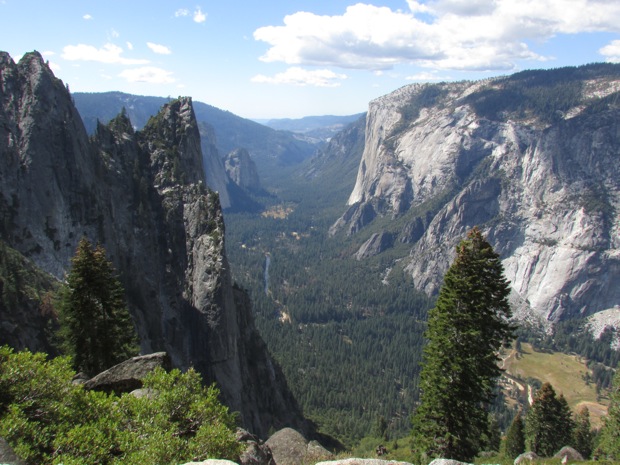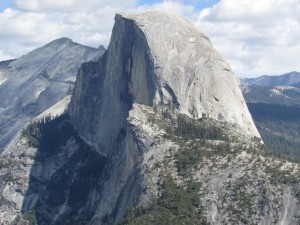It’s been a hard year for Yosemite National Park. First, the third-largest wildfire in California history torched its northwest corner. Then the government shutdown forced it to pass its 123rd birthday alone.
Whether this latter fact is good news or bad, however, may depend on your perspective. If you were planning to visit Yosemite in the last two weeks, it was surely bad. But if you worry about the ecological impact of the park’s nearly 4 million annual visitors, most of whom pass through the valley, a few days’ respite might seem to be a small upside to an otherwise bleak moment in American life.
I had the good fortune to plan my Yosemite trip for the week before the shutdown. It was late September, which meant little water in the falls and cold nights in the mountains. The park was relatively unpeopled; my backpacking companion and I had no trouble negotiating the park’s permit system, and were among only a handful of hearty Half Dome summiters. The panorama from the top was thrilling, as were the steep, cable-assisted climbs up and down. But probably the visual highlight of the trip for me happened the next day on the Four Mile Trail, which plunges from Glacier Point down more than 3000 feet to the Valley. One of the trail’s innumerable switchbacks opened up a breathtaking view to the west, between the towering cliffs of the Cathedral Spires and El Capitan. My friend said he felt like he was in Lord of the Rings; I felt transported into an Ansel Adams photograph.
Monumental western landscapes like Yosemite Valley and the Grand Canyon have long been important parts of the collective American consciousness. But I later learned that the iconic view my friend and I marveled at is actually a fairly recent invention. By coincidence (I assume), the day after we returned from Yosemite, environmental historian Bill Cronon and ecologist Paul Robbins from the University of Wisconsin, Madison were on the radio show Science Friday discussing, among other things, Yosemite. Cronon pointed out that though the park is often considered almost the definition of natural splendor, the iconic views from the valley floor are partly a human creation. Nineteenth century Native American fires opened up the floor’s forests, giving way to meadows and making visible the massive cliffs, which later inspired John Muir and others to push for making Yosemite a national park. Of course, one of the results of white people’s desire to marvel at Yosemite is that the native people who had made in the valley their home for millennia were forced out.
Cronin has long critiqued our cultural conception of wilderness as a place without people (“where man himself is a visitor who does not remain,” the 1964 Wilderness Act put it). Cronon’s University of Wisconsin colleague, the ecologist Don Waller, has also criticized our choices for wilderness from a biological perspective, arguing that U.S. agencies have historically prioritized the grandeur of “rocks and ice” over factors like biodiversity in land preservation decisions. At the same time, Waller has done research showing that “protected” areas in Wisconsin have often fared worse than other places in terms of plant biodiversity, largely because bans on hunting have allowed deer to flourish and devastate native plant communities. In Yosemite’s wilderness, park managers struggle to keep wildlife wild and maintain ecologically important fire regimes while still providing access to thousands of solitude-seeking hikers. Meanwhile, in the Valley, unlimited carloads and busloads of tourists arrive from all over the world, ready to admire cliffs and photograph deer and then perhaps relax with a beer in an air conditioned lodge. It is hard to imagine that when Muir and Teddy Roosevelt were standing at Glacier Point, they were imagining a scene below that would one day resemble, in the words of one Internet commenter, a Costco parking lot.
Yosemite is a quintessential example of a human paradox: we are attracted to wild landscapes, and yet we can’t seem to stop ourselves from taming them. The park’s soaring cliffs and exposed rock faces are as wild—by which I mean as nonhuman, as “other”—as any place I can remember being. We can’t make a living on them, and we aren’t meant to. And yet we are we powerfully drawn to this inhospitable place. Why? I submit that it is rock’s very otherness that transports us out of our normal lives and concerns. When I stand among huge cliffs, our everyday concerns are far away and our problems feel insignificant. As one shutdown-defying rock climber argued, we are free.
I abhor the government shutdown. I am outraged that politicians have blithely caused real pain to millions of federal workers and all those who depend on so-called “non-essential” government services. I am deeply saddened that this debacle will probably diminish America’s position as a leader in the scientific world, and I can’t help but wonder if such diminishment is partly what the extremists behind the shutdown were hoping for. And I feel sorry for all those people who were unable to make a long-planned visit to a beautiful place because of our elected officials’ childish behavior. The signs keeping Americans and others out of places we have supported through our own tax dollars were some of the most obviously infuriating symbols of this failure of democracy.
But the shutdown also provided an opportunity for us to think about what responsibilities might come with owning and control a piece of land, especially one that so many of us cherish. In Desert Solitaire, Edward Abbey decried the construction of access roads in Utah’s Arches National Monument, arguing that providing too much access could destroy the very thing people were coming to see. Yosemite Valley was probably already pretty far down that road in Abbey’s day, and I’m sure it has only gotten worse since. Many have suggested that the damming of the Tuolumne River, which flooded Hetch Hetchy, the next valley over from Yosemite, is what killed John Muir, who fought a bitter battle against it. But would he be any less pained by the present Disneyfication of Yosemite Valley? I doubt it.
As the shutdown ends and beloved Yosemite Valley fills with cars and people again, perhaps it is time to consider whether this is really the right way to treat a national treasure.


